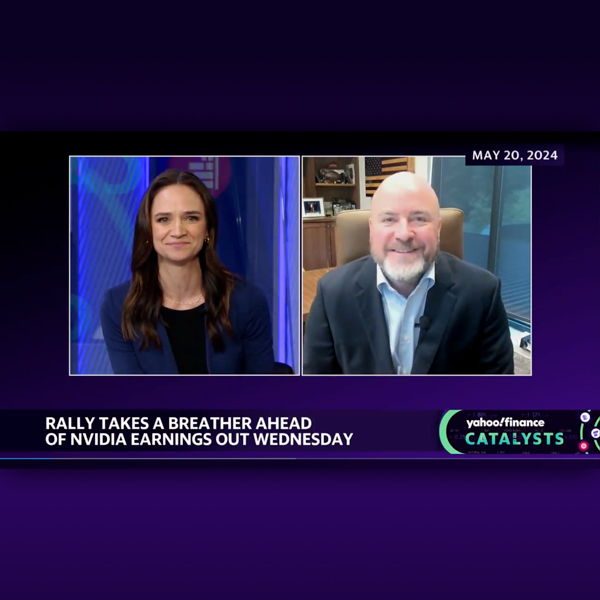First Franklin Financial Chief Market Strategist Brett Ewing joins Catalysts to discuss how investors should navigate markets around certain driver events. Watch the full video here.
Editor’s note: This article was written by Angel Smith
Markets have been on a remarkable rally, with the Dow Jones Industrial Average (^DJI) surpassing the 40,000 mark for the first time ever last week. However, markets seem to be taking a breather ahead of Nvidia’s (NVDA) much-anticipated fiscal first-quarter earnings results, expected on Wednesday, May 22.
First Franklin Financial Chief Market Strategist Brett Ewing joins Catalysts to discuss how investors should navigate markets (^IXIC, ^GSPC) around certain driver events.
Ewing acknowledges that Nvidia’s results “will play an important role” in shaping market sentiment in the short term. However, he emphasizes that the AI trend “is longer-term,” suggesting that regardless of how Nvidia’s results impact the market, “it will likely recover.” Additionally, Ewing notes that historically, markets tend to exhibit positive performance during election years.
Despite the anticipation surrounding Nvidia’s earnings, Ewing believes “we have a lot of positive tailwinds” that could contribute to market growth. He advises investors to explore opportunities in small and mid-cap stocks, which he believes could see “upside of over 40 to 60 percent over the next eighteen months.” Ewing points to the Russell 2000 index (^RUT), which has been stuck in a cycle, noting “the longer they stay in the more powerful the breakout can be.”
When asked about how he believes a Federal Reserve rate decision will affect market dynamics, Ewing responds, “I believe that a lot of that has already been priced in, and looking forward, the market is looking at rate cuts, and I think that’s what the sentiment should be.”
For more expert insight and the latest market action, click here to watch this full episode of Catalysts.
Automated Video Transcript
Major markets they are holding just near those record highs.
The dow those slipping a bit, investors taking a breather from that rally ahead of invidious earnings results out on Wednesday.
The chip giant is the largest contributor to earnings growth in the S and P 500.
Without it, the blended earnings growth rate for the index would fall from 5.7% to 3.2%.
That’s a the latest ad out from facts set to discuss how investors should position their portfolios.
How of the results we want to bring in Brett Ewing.
He is first a first Franklin Financial Chief Market strategist Brett.
I it’s great to have you here.
So talk to us says, is this or is it not a make or break moment here for the market in the context of NVIDIA earnings out on Wednesday?
Well, I certainly think that’s a big component and it’s gonna play an important role here in the short term with the market.
But I think the A I trend is a little bit longer term and the market will likely recover.
So just from a historical perspective, let’s talk about where we are in the market right here.
This is an election year.
I know a lot of people may not know that, but we are in an election year.
If you look back, going back to 1928 it, the markets are positive in an election year, over 83% of the time versus uh 69% of the time non election years.
Another thing I I would like to point out is that, look, we are likely in a low bed cut cycle right here and that is absolutely goldilocks for stock markets.
If you go back and look at all the eight cycles going back to 1950 and you look at all those slow cut rate cycles, the average return from the very first cut is about 23%.
So I, I throw that out there for your viewers.
I think those are some important facts to look at right here.
Well, I’m curious about your thoughts on the conviction behind that momentum that you look at historically.
Do you think that this is a close your eyes, hold your nose and buy environment?
I never think that, but I do believe we have a lot of positive tailwinds again with the FED, I think over the next two years, um We’re looking at areas uh in small and mid cap.
I think that that’s one of the uh least talked about areas of the market.
And I think the opportunity there could be upside of over 40 to 60% over the next 18 months and, you know, small midcap stocks.
If you look at the Russell 2000, for example, it’s been in a 24 month channel.
It’s been in a box.
It’s been trying to break out of that channel.
It’s attempted five times the sixth attempt just recently here in March, it actually broke out of that channel.
Now, that’s the fourth longest streak of being trapped in the channel in its history.
And the longer they stay in, the more powerful the breakout could be.
But Brett, I’m curious about your take on that because small caps are the ones that are most likely to be negatively impacted by higher for longer, given the amount of debt that they have and the inability to refinance.
So how are they going to be able to withstand that headwind?
I think a lot of all that is priced in as you can see the recent move that we’ve had in the small cap index dating back to October of 23.
Um I believe that a lot of that’s already been priced in and looking forward the market is looking at rate cuts and I think that’s what the sentiment should be.
And I think the opportunity of getting ahead of the first rate cut is very important with the small cap index.

